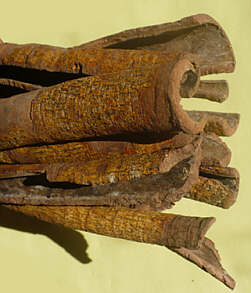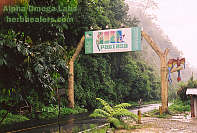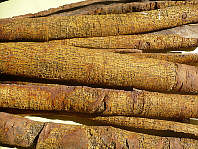|
An Amazonian Traditional for Arthritis & Bursitis

Choo-choo-Wáso
(Maytenus macracarpa [Past.])
Concentrated Tincture of the
Inner Bark of Chuchuguazo
Code 318A -- Price: $19.95
8 fl. oz. (240 ml.)
Dosage: 3 ml., 2X Daily
(One bottle lasts 40 days)
Order Now
 Email
Email
Summarized Description:
Choo-choo-Wáso (TM) is an herbal tincture made from
the inner bark of "chuchuguazo" (its common name in Pastazan
Shuar),
a large canopy tree found in the Amazon in Ecuador and Peru (where it is called
"chuchuasi" or "chuchuasha.") [ 1 ]
It is one of our Amazonian traditionals. [ 2 ]
The most common indigenous use of chuchuguazo in the Amazon
is the treatment of arthritis -- for which many people have reported
success in our travels through the Amazon.
 See
Protocol and Usage section below.
 hoo-choo-Wáso (TM)
is a potent herbal tincture traditional from the Amazon,
commonly used to treat primarily arthritis and bursitis conditions; and secondly,
general bone pain and stomach ache. Our version of this product is made with
puro (grain alcohol made from sugar cane) and can be consumed fresh or
after heating in a tea pan to flash off the alcohol. hoo-choo-Wáso (TM)
is a potent herbal tincture traditional from the Amazon,
commonly used to treat primarily arthritis and bursitis conditions; and secondly,
general bone pain and stomach ache. Our version of this product is made with
puro (grain alcohol made from sugar cane) and can be consumed fresh or
after heating in a tea pan to flash off the alcohol.
 Like many alcohol-based herbal tinctures,
many will find formula overpowering without the addition of honey, molasses or other sweetener. Like many alcohol-based herbal tinctures,
many will find formula overpowering without the addition of honey, molasses or other sweetener.
Uses & Protocols
 The following uses and protocols
are well-established among the Shuar of the Ecuadorean oriénte.
As is the case with other Amazonian traditionals,
please note that these are indigenous uses. Additionally, the use of this product
is supported by the widespread sale of chuchuguazo bark in the "féria libres" (open
farmer markets) of Ecuador. This ethnobotanical information is provided as a guideline
to how others use this product. The following uses and protocols
are well-established among the Shuar of the Ecuadorean oriénte.
As is the case with other Amazonian traditionals,
please note that these are indigenous uses. Additionally, the use of this product
is supported by the widespread sale of chuchuguazo bark in the "féria libres" (open
farmer markets) of Ecuador. This ethnobotanical information is provided as a guideline
to how others use this product.
 Dosage: Begin with three milliliters
(slightly over one half teaspoon), 2X daily -- taken before breakfast and lunch.
(The traditional dose in the Amazon calls for a "cucharita" (Spanish for teaspoon)
taken before breakfast, lunch, and dinner for ten days to eliminate arthritis
and bursitis . . . a claim that needs to be researched. For our part, we have
already interviewed numerous users who attest to its general effectiveness for,
as they say here, "bone pain".) Dosage: Begin with three milliliters
(slightly over one half teaspoon), 2X daily -- taken before breakfast and lunch.
(The traditional dose in the Amazon calls for a "cucharita" (Spanish for teaspoon)
taken before breakfast, lunch, and dinner for ten days to eliminate arthritis
and bursitis . . . a claim that needs to be researched. For our part, we have
already interviewed numerous users who attest to its general effectiveness for,
as they say here, "bone pain".)
Contraindications
 Similiar to other Amazonian
traditionals, the contraindications for this product are
primarily dietary: during treatment period, do not consume pork, cow's meat,
chicken, or sea fish. Freshwater fish is alright. Similiar to other Amazonian
traditionals, the contraindications for this product are
primarily dietary: during treatment period, do not consume pork, cow's meat,
chicken, or sea fish. Freshwater fish is alright.
 As is the case with all herbal tinctures,
be sure to consult your physician first if you are taking any prescribed medications.
This product contains alcohol, which may be contraindicated with a prescription
you may be taking. As is the case with all herbal tinctures,
be sure to consult your physician first if you are taking any prescribed medications.
This product contains alcohol, which may be contraindicated with a prescription
you may be taking.
Shelf-Life
 This herbal tincture has a functional
shelf-life that is guaranteed to be in excess of four years from the date
of purchase. This herbal tincture has a functional
shelf-life that is guaranteed to be in excess of four years from the date
of purchase.
|
 To U.S. Users: To U.S. Users: This product
have not been evaluated by the U.S. Food & Drug Administration.
It is not intended to diagnose, treat, cure, or prevent any disease.
|
 Sourcing From
Sourcing From
The Amazon
 All the materials used to
make our Choo-choo-wáso are wild-crafted and harvested
from deep in the provinces of Pastaza and Moreno Santiago, near the
Peruvian border. There are no cultivated varieties.
Click photo to enlarge.
 Question Over
Question Over
Identification
 In his extensive botanical
treatise, Medicinal Plants of Latin America, Dr. James Duke
laments the variety of species covered by the same term "chuchuhausi"
(under "Heisteria acuminata (Humb. & Bonpl.) Engl.)", p. 350).
The phonetical proximity of this term, presumably Peruvian, to
"chuchuguaso" (i.e. only the final vowel makes it sound different)
alerted us to its relation.
 We freely admit that
because of the isolated area where we are getting the particular
tree variety we use to make this product, that it might be
an unnamed species under either genus "Heisteria" or "Maytenus."
However, we chose to use it because it has a long-standing history
of usage by the peoples in that area. There have not been any
reports of side effects or adverse reactions. Its place in
the indigenous community there is tried and true.
 Our choice of
"Maytenus macracarpa" is based on the close relation of our
plant to one of the same physical characteristics in Peru.
It not only has similar physical characteristics, but has the
same intended use, traditional manner of preparation, etc.
 Interestingly, Duke
provides information on two other species of the genus "Maytenus",
(family: "Celastraceae"). Neither of those two species,
Mayten ( Maytenus boaria Molina) or Holy Thorn
( Maytenus ilicifolia Mart. ex Reissek) match those of
the tree in question, or any of its parts.
 Mayten Mayten has native
applications as a purgative and febrifuge, with no mention as
an anti-arthritic, while Holy Thorn has wide-ranging uses
in Argentina, Brazil, Uruguay and Paraguay -- among them as an
aphrodisiac and abortifacient -- none of which apply to this
plant bark and its common usage.
|


 hoo-choo-Wáso (TM)
is a potent herbal tincture traditional from the Amazon,
commonly used to treat primarily arthritis and bursitis conditions; and secondly,
general bone pain and stomach ache. Our version of this product is made with
puro (grain alcohol made from sugar cane) and can be consumed fresh or
after heating in a tea pan to flash off the alcohol.
hoo-choo-Wáso (TM)
is a potent herbal tincture traditional from the Amazon,
commonly used to treat primarily arthritis and bursitis conditions; and secondly,
general bone pain and stomach ache. Our version of this product is made with
puro (grain alcohol made from sugar cane) and can be consumed fresh or
after heating in a tea pan to flash off the alcohol.
